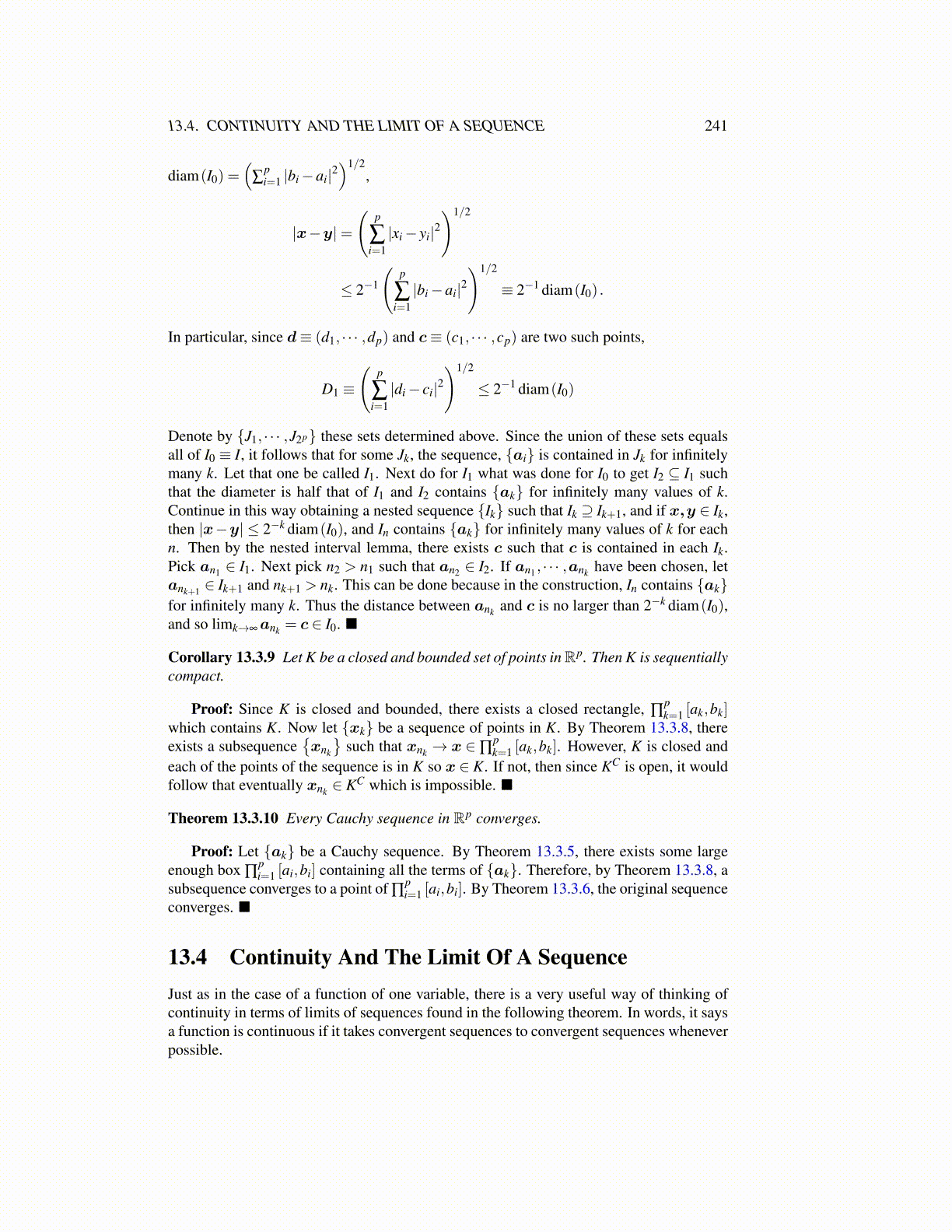
13.4. CONTINUITY AND THE LIMIT OF A SEQUENCE 241
diam(I0) =(
∑pi=1 |bi−ai|2
)1/2,
|x−y|=
(p
∑i=1|xi− yi|2
)1/2
≤ 2−1
(p
∑i=1|bi−ai|2
)1/2
≡ 2−1 diam(I0) .
In particular, since d≡ (d1, · · · ,dp) and c≡ (c1, · · · ,cp) are two such points,
D1 ≡
(p
∑i=1|di− ci|2
)1/2
≤ 2−1 diam(I0)
Denote by {J1, · · · ,J2p} these sets determined above. Since the union of these sets equalsall of I0 ≡ I, it follows that for some Jk, the sequence, {ai} is contained in Jk for infinitelymany k. Let that one be called I1. Next do for I1 what was done for I0 to get I2 ⊆ I1 suchthat the diameter is half that of I1 and I2 contains {ak} for infinitely many values of k.Continue in this way obtaining a nested sequence {Ik} such that Ik ⊇ Ik+1, and if x,y ∈ Ik,then |x−y| ≤ 2−k diam(I0), and In contains {ak} for infinitely many values of k for eachn. Then by the nested interval lemma, there exists c such that c is contained in each Ik.Pick an1 ∈ I1. Next pick n2 > n1 such that an2 ∈ I2. If an1 , · · · ,ank have been chosen, letank+1 ∈ Ik+1 and nk+1 > nk. This can be done because in the construction, In contains {ak}for infinitely many k. Thus the distance between ank and c is no larger than 2−k diam(I0),and so limk→∞ank = c ∈ I0. ■
Corollary 13.3.9 Let K be a closed and bounded set of points in Rp. Then K is sequentiallycompact.
Proof: Since K is closed and bounded, there exists a closed rectangle, ∏pk=1 [ak,bk]
which contains K. Now let {xk} be a sequence of points in K. By Theorem 13.3.8, thereexists a subsequence
{xnk
}such that xnk → x ∈∏
pk=1 [ak,bk]. However, K is closed and
each of the points of the sequence is in K so x ∈ K. If not, then since KC is open, it wouldfollow that eventually xnk ∈ KC which is impossible. ■
Theorem 13.3.10 Every Cauchy sequence in Rp converges.
Proof: Let {ak} be a Cauchy sequence. By Theorem 13.3.5, there exists some largeenough box ∏
pi=1 [ai,bi] containing all the terms of {ak}. Therefore, by Theorem 13.3.8, a
subsequence converges to a point of ∏pi=1 [ai,bi]. By Theorem 13.3.6, the original sequence
converges. ■
13.4 Continuity And The Limit Of A SequenceJust as in the case of a function of one variable, there is a very useful way of thinking ofcontinuity in terms of limits of sequences found in the following theorem. In words, it saysa function is continuous if it takes convergent sequences to convergent sequences wheneverpossible.